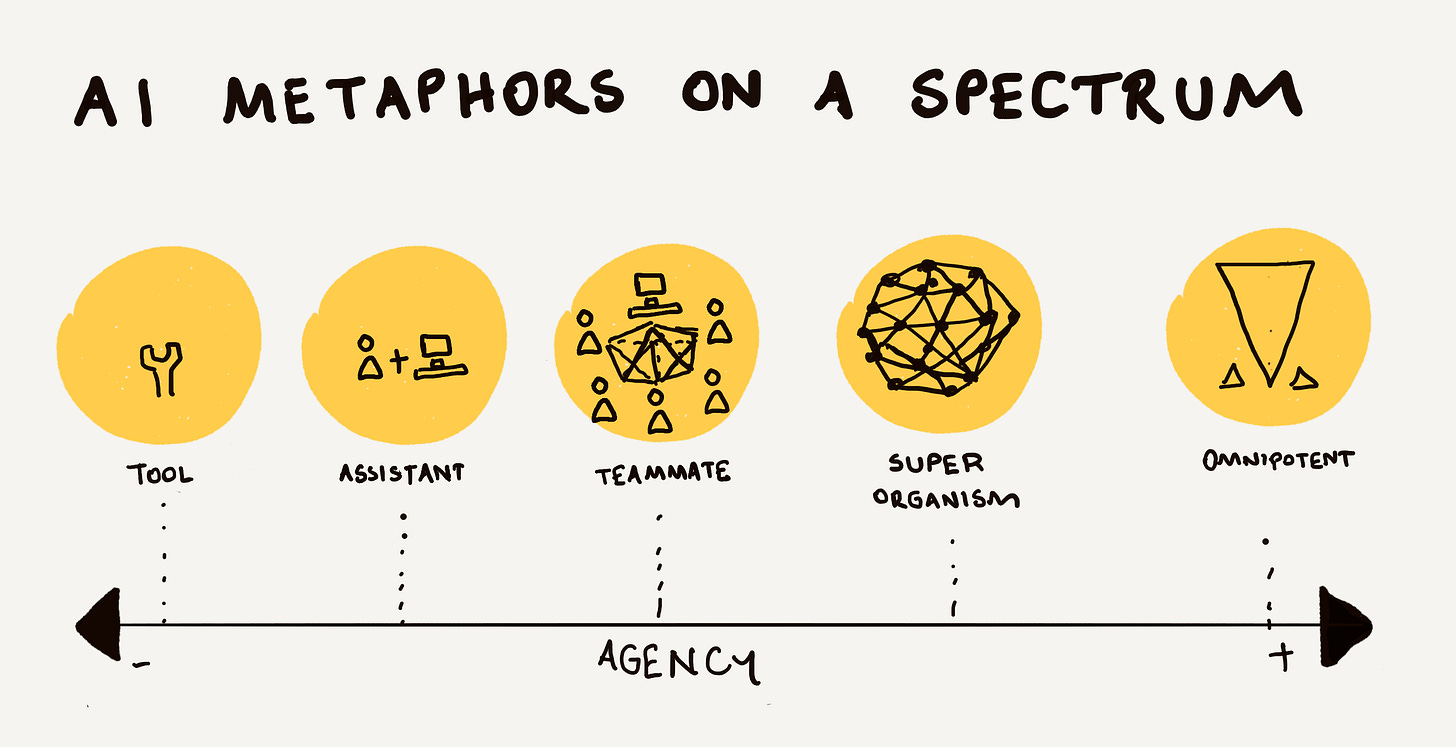Tell Me Your AI Metaphor, and I Tell You What It's Up To
AI Metaphors and What It Means For Our Understanding and Imagination
Welcome to the seventh issue of Culturescapes by Kursat Ozenc. This newsletter examines culture through the design lens. It discusses big ideas and small practices for crafting better cultures in our personal, work, and social spheres and their intersection with technology.
The central idea in this issue is that the metaphors we choose to explain and design AI matter.
By mapping unfamiliar experiences to familiar ones, metaphors empower us to grasp and shape complex concepts, such as artificial intelligence (AI). Metaphors communicate, highlight, and filter out certain aspects of an idea. And they can shape our perceptions and behavior. Let's illustrate the power of metaphor with an example. Onboarding employees is a pristine moment for organizations. To help grasp its importance, we can position onboarding as a tribal initiation. Using the tribe metaphor, we signal the high-stakes nature of the experience. Further, we can shape onboarding by proposing a treasure hunt metaphor, which opens up a fantastic set of possibilities for creating a fulfilling onboarding experience.
Returning to artificial intelligence, let's consider the metaphors people commonly use to explain and shape AI. What implications do they carry?
I've identified five metaphors frequently emerging in AI discussions: AI as a tool, AI as an assistant, AI as a teammate, AI as a superorganism, and AI as an omnipotent entity/God-like. These metaphors show a spectrum of AI’s ability to act independently (agency). As its agency moves from tool to omnipotency, the transparency of its decisions also gets complicated.
At the lowest end of the agency spectrum, we see AI as a tool metaphor, meaning that AI is an extension of humans. It’s tamed and is an updated version of a calculator. Such a metaphor reinforces the idea that AI serves human purposes and decisions.
When we frame AI as an assistant, human agency is still relatively high; AI assists with tasks but does not replace human decision-making. Employees direct AI's tasks and integrate its outputs into their workflows. Transparency becomes important, especially in understanding the basis on which the AI provides assistance and suggestions.
Framing AI as a teammate implies a more collaborative and interactive role as we share our agency with the machine. This sharing raises questions about who does what and how. This metaphor is the most exciting for me as it can open up possibilities to solve complex challenges(i.e., wicked diseases, such as cancer). AI teammates can handle data-heavy tasks beyond the typical scope of human capabilities, allowing human team members to focus on areas where they excel, such as strategic thinking and creativity.
Finally, when we frame AI as a superorganism or an omnipotent being, our agency could become minuscule, and risks around ethics and bias could become gigantic. The dystopian futures in TV series like Mrs. Davis and Black Mirror can hint at what's at stake. Individual contributions may feel less impactful as the AI system operates with a high degree of autonomy and integration across the organization.
The metaphor we choose significantly influences how AI is integrated into organizational culture and operations, impacting both perceived and actual human agency and the level of achievable transparency. We need to ensure that AI applications align with organizational values and put guardrails for openness. This is essential for creating a healthy workplace where technology enhances human contributions rather than diminishes them.
A couple of suggestions when it comes to leveraging metaphors in understanding the complexities and generating ideas on AI:
Test your metaphors with storytelling. Metaphors are good for articulating your understanding of AI, so use them more often. Treat them as prototypes, test them by telling a story around them, and see if it resonate with people. For instance, you can position my human-AI team as a tribe, a guild, or a family. Each opens up different trajectories and implications.
Consider the risks of your metaphor upfront: Once you choose a metaphor, it's crucial to be mindful of its implications, especially on agency. Risks include explainability, transparency, safety, fairness, and how your metaphor drives decisions about people's livelihood, dignity, and well-being. This awareness will make you feel more cautious and responsible in your approach.
Use metaphors for ideation: Metaphors can be robust catalysts for generating ideas. In our design thinking workshops, metaphors often spark the most intriguing discussions. For example, imagine you're designing your AI experience as a Disney Theme Park. How would Disney approach your AI? This exercise stimulates creativity and encourages leading with metaphor.
What I am reading & listening
I recommend Metaphors We Live By by George Lakoff and Mark Johnson to double-click on metaphors. It’s one of the seminal books highlighting metaphors’ powers to shape our perceptions and behaviors.
This is the end of the seventh Culturescapes issue. Until then, take good care of yourself and your loved ones!





A podcast with Sal Khan (iTunes Possible podcast) is very instructive, specially applied to K-12 education.
https://podcasts.apple.com/us/podcast/possible/id1677184070?i=1000641143061